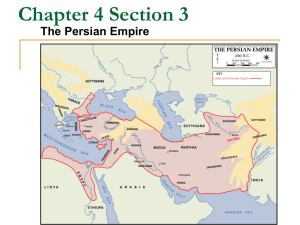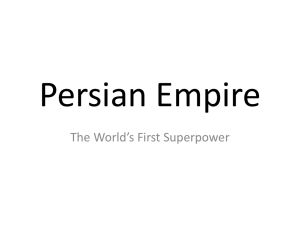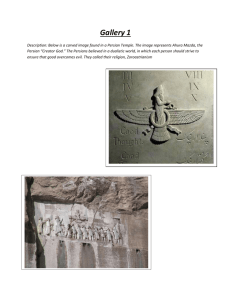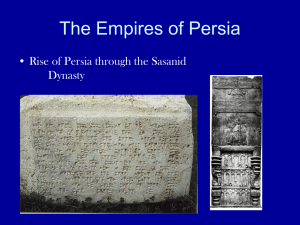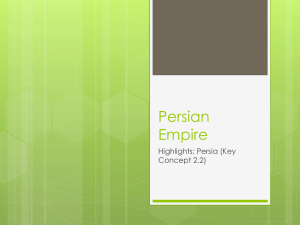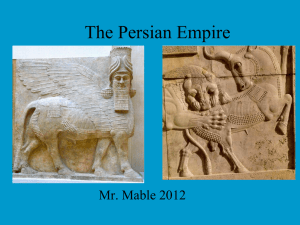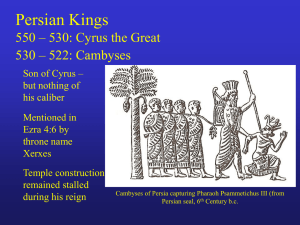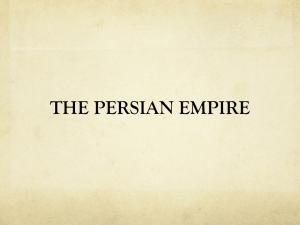Persia
advertisement
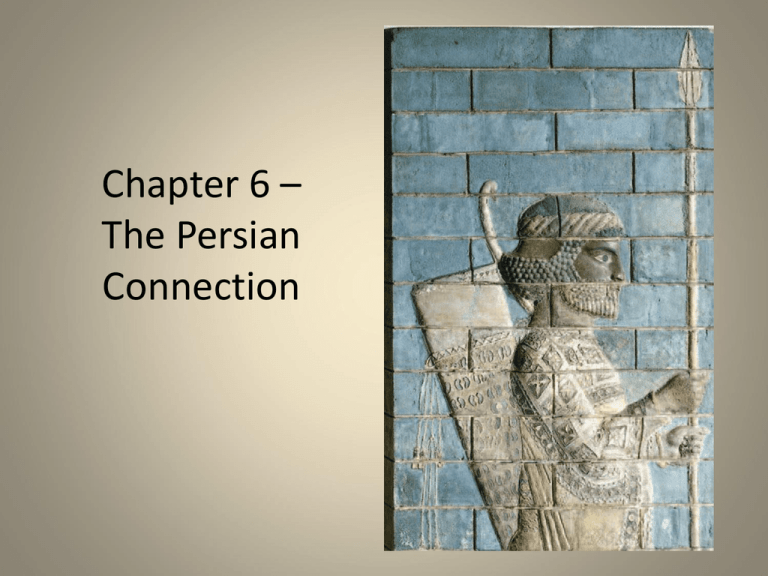
Chapter 6 – The Persian Connection Development of Empire • Approximately 1000 BCE, Indo-European tribes from Central Asia migrate to Iranian Plateau • Iran translates as “land of Aryans” • Two Subgroups: Medes – Zargos Mountain Region • Persians – Central Plain Farsi Region Environmental Trade-offs • Unlike other early cultures, Persia did (does) not have large rivers • Arid and desert • Small rivers • Nomads herded grazing animals to Plateau • Migrants came from northern steppes – area of great grazing, but often invaded • Persia offered protection from invasion – surrounded by mountain ranges and deserts Zagros Mountains Northwestern Persia Nisaean Plain Qanat Irrigation System Digging a Qanat Inside a Qanat End of a Qanat Aerial View of Qanat Aerial View of Qanat Spread of Qanat System A Modern Qanat – Still Used Today Persian Ruling Family – Achaemenid • Intermarried with Medes to establish power and legitimize bloodline for rule • Cyrus the Great (child of the Persian/Mede union) • 550 BCE captured king (his father-in-law) and united Persians and Medes Cyrus’ Military Conquests • • • • • • • Defeated Medes, united Persia Lydia Greek city-states in Anatolia Afghanistan Mesopotamia Palestine From Aegean Sea in west to Hindu Kush mountains in east Aryan Script The Cyrus Cylinder 539 BCE Questions of Empire • How to rule and administer far-flung empire? • How to treat and maintain control of peoples from various cultures? • Different forms of power? • Different ways to gain allegiance from various people? • Can various peoples maintain their own cultures when under the rule of someone else? • Why would various peoples submit to imperial rule? Principles Established by Cyrus the Great: (1) (2) (3) (4) (5) Rule through persuasion and compromise rather than force and humiliation Treated conquered people with kindness – allowed deported people to return to their homelands Permitted defeated people to retain their own religion and cultural practices, and offered partnership in Persian empire Standardized taxes and measurements Fostered commercial and cultural networks in empire (Royal Road) http://www.iranchamber.com/history/cyrus/cyrus_charter.php Cyrus the Great Cylinder Tomb of Cyrus the Great Site contains: Tomb of Cyrus, a monumental Satellite Map of Site gatehouse, two palaces, a royal garden, an enigmatic stone tower (the Zendan-i Suleiman), two hollow limestone plinths, and an impressive stone platform jutting from the western side of a low hill or "throne hill." Empire in Disarray – Rise of Darius • • • • • • No clear ruler after Cyrus’ son died Darius claimed throne, married Cyrus’ son’s wife and Cyrus’ daughter Claimed divine support Waited a brief period before expanding kingdom First conquests in East into India Pressed into Northern Europe – Danube River by 512 BCE One of the building inscriptions at Persepolis, known as DPa. "Darius, the great king, king of kings, king of countries, Hystapeses’ son, an Achaemenid, built this palace". Darius (Continued) • Chose Strong Central Rule – emphasized Authority • Divided empire into twenty provinces (satrapies) • Governor – Satrap (Note the importance of the Satrap, p. 142 Connections) • Established system of royal judges to ensure local laws enforced • Authorized compilation and codification of Persian laws See the Video Link for Persepolis in Blackboard Darius’ Seal of Office The cuneiform inscription in Old Persian, Elamite and Babylonian reads: ‘I [am] Darius, great king’ (the word ‘great’ only occurs in Babylonian). Persian Satrapies Satrap Receiving Visitors Darius’ Royal Road Royal Road Today (in Turkey) Archaeology Along Royal Road (Turkey) Royal Road Bridge at Pol-e Dokhtar, Iran Royal Road Bridge at Pol-e Dokhtar Satellite Map Darius’ Behistun Inscription • Behistun – Large rock along Royal Road between different Persian capitals – many travelers passed by site • Logical place for Darius to proclaim his accomplishments • Satellite map of site Behistun Inscription Inscription tells of Darius’ victories (symbolized by 10 subject peoples), overseen by the god Ahuramazda – 3 versions of text in Old Persian, Babylonian, and Elamite Achaemenid Dynasty Sites and Artifacts • CAIS link to sites and artifacts • Livius.org info on different Persian sites Persepolis Zoroastrianism as a Religion • “Good thoughts, good words, • Religion is dualistic – a and good deeds” constant struggle between the two deities for mankind (humata, hukhta, huvarshta) and the world (good vs. evil) Saoshyant – Savior Figure at • Ahura Mazda – chief deity the End of Time that will (“Wise Lord”) reign • Angra Mainyo (or Ahriman) – Antagonist of Ahura Mazda (evil) • Final Judgment of Fire, Ahura Mazda controls this judgment. Features of Zoroastrianism (1) (2) (3) (4) Ethics – morality as ideal and achievement Eschatology – expectation of a world to come Personification of Evil (protagaonist/antagonist) Fire as a central part of worship (symbol of divine presence) Standard Prayer for Zoroastrian ceremonies is a prayer for health, long life and good fortune – called the Tan Dorosti (Healthy Body) BBC ‘Story of God’ video links: Part One (animism, cave art) Zoroastrianism Confrontation with Greece Cyrus • 546 BCE conquered Lydia and Western Anatolia – Greeks were forced to submit, but resentment built over differences in culture and government • 499 BCE Ionian Revolt (City-states revolted against Persian Rule) B. Darius and the Ionian Revolt • 494 BCE Darius sent ambassadors to Greek mainland to suppress rebellions and force dominance of Aegean Commerce • Athens and Sparta killed his messengers and offended Persia • 492 BCE Battle of Marathon (at Marathon Bay) http://www.youtube.com/watch?v=oTgez_mzfCY Youtube link for History Channel Battle of Marathon Part 1 (Try to watch part 1, 2 and 3) • After the Persians were defeated at Marathon, Darius was positive he must forcefully conquer Greece

